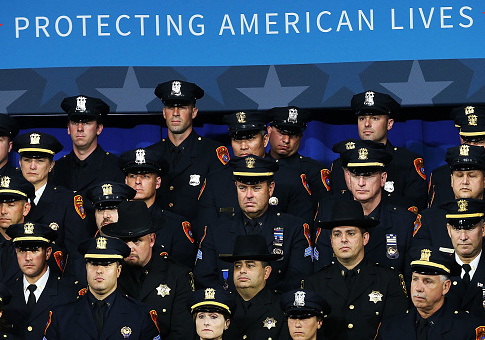An increase in the number of policemen, driven by an Obama-era boost in federal funding, led to drops in violent and property crime, including a reduction of one murder per every 11 police officers, a new paper argues.
The analysis, authored by Princeton Ph.D. candidate Steve Mello, examines what Mello identifies as a natural experiment in the relationship between the number of police and the rates of crime in a given jurisdiction.
Specifically, Mello focuses on the increase in police funding that came when a newly elected President Barack Obama signed the American Recovery and Reinvestment Act into law, allocating some $2 billion to the Department of Justice for police hiring grants, mostly through the Department's Community Oriented Policing Services (COPS) program. COPS grants were issued based on a "fuzzy cutoff," meaning a city's chances of receiving a grant jumped substantially if its scoring by DOJ (a combination of factors including crime rate and current police force size) passed a certain threshold. That fuzzy cutoff creates two natural groups for comparison: Those that received COPS funding and those that didn't.
Mello demonstrates that, while "high and low scoring cities follow[ed] similar trends in police and crime prior to the application year," cities above the threshold saw a 3.6 percent increase in police. This translated into a 4.8 percent decline in violent crimes and a 3 percent decline in property crimes for cities over the threshold, over average, an effect which Mello ties directly to the increase in police.
Those declines are driven especially by police effects on robbery, larceny, and auto theft, Mello notes. But police also exert a notable downwards pressure on murder rates, with the analysis finding a particularly robust negative response: For every 11 police officers hired, one murder is prevented.
The analysis concludes these declines are not driven merely by incapacitation, i.e. the prevention of crime by the physical removal of offenders from the streets. To determine this, Mello analyzed arrest rates and found they did not increase concurrently with the increase in number of police officers.
This, Mello argues, "suggests a deterrence mechanism underlying the estimated crime effects," with the simple presence of additional police reducing criminals' likelihood of committing a crime.
Mello's paper contributes to a growing body of research that supports a relationship between an increase in the number of police officers and a decline in the crime rate. This seemingly intuitive point struggled to find empirical verification until a 1997 paper by noted University of Chicago economist Steven Levitt analyzed the effects of police hiring driven by the ostensibly independent variable of electoral cycles, at last identifying a relationship between cops and crime.
Since then, the literature has grown, including more than one other analyses of COPS, and a natural experiment analyzed by Jonathan Klick and Alexander Tabarrok, who found fluctuations in police around the Capitol in Washington, D.C., affected crime rates.
Mello's paper provides a novel contribution to this body of literature because "several of the most-cited papers on the topic have studied the high crime periods of the 1980's and 1990's," whereas Mello "study[s] a period with low and falling crime rates and show[s] that additional police still have a meaningful impact in this very different environment."
This means that even during the notably low-crime 2010 to 2013 period police still drove crime rates down. Today, the 20-year crime decline may be in jeopardy: after having risen for two years in a row, violent crime rates fell in the first half of 2017, but murder continued to increase.
Funding for police hiring, specifically through COPS, has been a priority of the Department of Justice under Attorney General Jeff Sessions. In November, Sessions announced $98 million in new COPS grants, allowing 179 law enforcement agencies nationwide to hire 802 new full-time officers. COPS has provided over $14 billion in funding since 1994.
